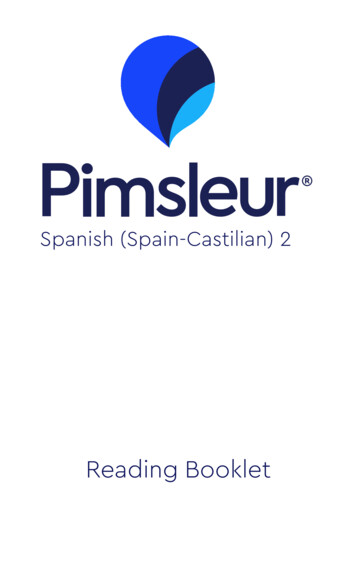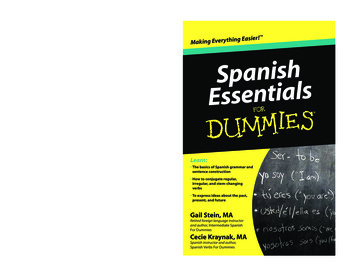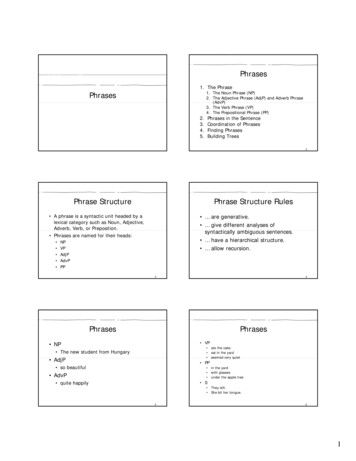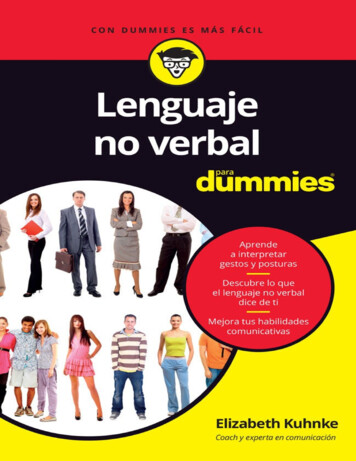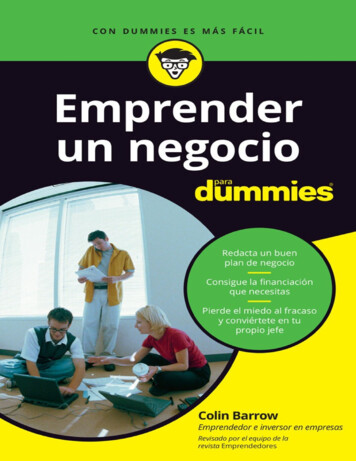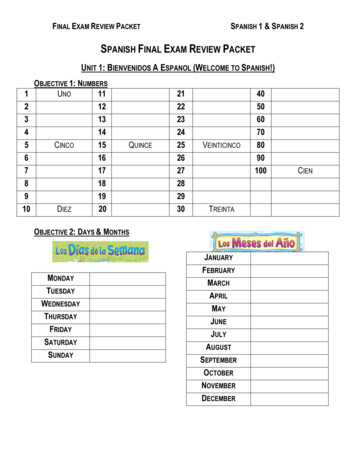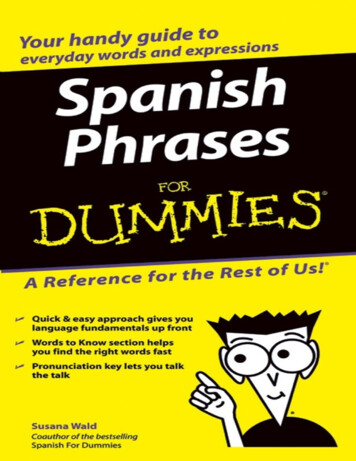
Transcription
Spanish Phrases For Dummiesby Susana Wald
Spanish Phrases For Dummies Published byWiley Publishing, Inc.111 River St.Hoboken, NJ 07030-5774www.wiley.comCopyright 2004 by Wiley Publishing, Inc., Indianapolis, Indiana Publishedby Wiley Publishing, Inc., Indianapolis, Indiana Published simultaneously inCanadaNo part of this publication may be reproduced, stored in a retrieval system, ortransmitted in any form or by any means, electronic, mechanical,photocopying, recording, scanning, or otherwise, except as permitted underSections 107 or 108 of the 1976 United States Copyright Act, without eitherthe prior written permission of the Publisher, or authorization throughpayment of the appropriate per-copy fee to the Copyright Clearance Center,222 Rosewood Drive, Danvers, MA 01923, 978-750-8400, fax 978-646-8600.Requests to the Publisher for permission should be addressed to the LegalDepartment, Wiley Publishing, Inc., 10475 Crosspoint Blvd., Indianapolis, IN46256, 317-572-3447, fax 317-572-4355, or e-mailbrandreview@wiley.com.Trademarks: Wiley, the Wiley Publishing logo, For Dummies, the DummiesMan logo, A Reference for the Rest of Us!, The Dummies Way, DummiesDaily, The Fun and Easy Way, Dummies.com and related trade dress aretrademarks or registered trademarks of John Wiley & Sons, Inc. and/or itsaffiliates in the United States and other countries, and may not be usedwithout written permission. All other trademarks are the property of their
respective owners. Wiley Publishing, Inc., is not associated with any productor vendor mentioned in this book.LIMIT OF LIABILITY/DISCLAIMER OF WARRANTY: The publisherand the author make no representations or warranties with respect to theaccuracy or completeness of the contents of this work and specificallydisclaim all warranties, including without limitation warranties of fitness fora particular purpose. No warranty may be created or extended by sales orpromotional materials. The advice and strategies contained herein may notbe suitable for every situation. This work is sold with the understanding thatthe publisher is not engaged in rendering legal, accounting, or otherprofessional services. If professional assistance is required, the services of acompetent professional person should be sought. Neither the publisher northe author shall be liable for damages arising herefrom. The fact that anorganization or Website is referred to in this work as a citation and/or apotential source of further information does not mean that the author or thepublisher endorses the information the organization or Website may provideor recommendations it may make. Further, readers should be aware thatInternet Websites listed in this work may have changed or disappearedbetween when this work was written and when it is read.For general information on our other products and services or to obtaintechnical support, please contact our Customer Care Department within theU.S. at 800-762-2974, outside the U.S. at 317-572-3993, or fax 317-5724002.Wiley also publishes its books in a variety of electronic formats. Somecontent that appears in print may not be available in electronic books.Library of Congress Control Number: 2004107388.ISBN: 978-0-7645-7204-3
Manufactured in the United States of America10 9 81B/QS/QX/QU/IN
About the AuthorSusana Wald is a writer and simultaneous and literary translator inHungarian, Spanish, English, and French. As a publisher, she has beenworking with books and authors for many years. She has been a teacher inChile and in Canada and has known the joy of learning from her students andtheir untiring enthusiasm and tolerance. She also is an artist and has had herwork shown in many countries in Europe and in North, Central, and SouthAmerica.
Publisher’s AcknowledgmentsWe’re proud of this book; please send us your comments through ourDummies online registration form located at www.dummies.com/register/.Some of the people who helped bring this book to market include thefollowing: Acquisitions, Editorial, and Media Development Compiler: LauraPetersonSenior Project Editor: Tim GallanAcquisitions Editor: Stacy KennedyCopy Editors: Laura K. Miller, E. Neil Johnson Assistant Editor: HollyGastineau-Grimes Technical Editor: Language Training Center EditorialManager: Christine Meloy Beck Editorial Assistant: Courtney Allen, MelissaS. Bennett Cartoons: Rich Tennant, www.the5thwave.comProductionProject Coordinator: Nancee ReevesLayout and Graphics: Stephanie Jumper, Michael Kruzil, Heather Ryan,Jacque Schneider, Julie Trippetti, Proofreaders: Angel Perez, Brian H. WallsIndexer: Joan GriffittsPublishing and Editorial for Consumer DummiesDiane Graves Steele, Vice President and Publisher, Consumer Dummies
Joyce Pepple, Acquisitions Director, Consumer Dummies Kristin A.Cocks, Product Development Director, Consumer Dummies MichaelSpring, Vice President and Publisher, Travel Brice Gosnell, AssociatePublisher, Travel Kelly Regan, Editorial Director, Travel Publishing forTechnology DummiesAndy Cummings, Vice President and Publisher, DummiesTechnology/General User Composition ServicesGerry Fahey, Vice President of Production Services Debbie Stailey,Director of Composition Services
ContentsTitleIntroductionAbout This BookConventions Used in This BookFoolish AssumptionsIcons Used in This BookWhere to Go from HereChapter 1: I Say It How? Speaking SpanishYou Already Know Some SpanishReciting Your ABC’sPronunciation and Stress¡Punctuation Plus!Some Basic Phrases to KnowChapter 2: Grammar on a Diet: Just the BasicsSentence ConstructionVerbsForming QuestionsPronouns in HidingThat Whole Gender ThingMake It Two (or More): PluralsTelling Tales with AdjectivesIt’s You, You Know: The Tú/Usted Issue
Chapter 3: Numerical Gumbo: Counting of All Kinds1, 2, 3: Cardinal NumbersDiscovering Ordinal NumbersTelling TimeDays, Months, SeasonsCounting Your MoneyChapter 4: Making New Friends and Enjoying Small TalkHello! Greetings and IntroductionsSmall-Talk VerbsGrand Inquisitor: QuestionsA Rainy Day: Talking WeatherHow Is Your Family?Chapter 5: Enjoying a Drink and a Snack (or Meal!)Getting the Table and Meal BasicsThree Verbs Used at the TableAt the RestaurantWhat’s on the Menu?The Bill, PleaseChapter 6: Shop ’Til You DropHeading Out on the TownShopping the Traditional MarketVisiting the SupermarketBartering for Your GoodsGetting the Right QuantityComparing Better or Best
Chapter 7: Making Leisure a Top PriorityHaving a Good TimeHaving a Good Time at Shows and EventsEnjoying the OutdoorsSports, Sports, SportsChapter 8: When You Gotta WorkPicking Up the PhoneOutside the OfficeInside the OfficePacking a PCChapter 9: I Get Around: TransportationOn the Go: TransportationPassing Passport ControlTransportation VerbsAsking for DirectionsChapter 10: Laying Down Your Weary Head: House or Hotel?Speaking of Houses . . .Scoping Out the HotelRegistering for a RoomDormir: The Sleeping VerbDespertar: The Waking Up VerbChapter 11: Dealing with EmergenciesShouting for HelpHandling Health Problems
Getting Help with Legal ProblemsDealing with Car EmergenciesChapter 12: Favorite Spanish Expressions¿Qué tal?¿Quiubo?¿Qué pasó?¿Cómo van las cosas?¡Del uno!¿Cuánto cuesta?¿A cuánto?¡Un asalto!¡Una ganga!¡Buen provecho!¡Salud!¡Buen viaje!Chapter 13: Phrases That Make You Sound Like a Local¡Esta es la mía!¿Y eso con qué se come?Voy a ir de farraCaer fatalNos divertimos en grandeVer negro paraPasó sin pena ni gloria¡Así a secas!¡La cosa va viento en popa!
IntroductionAs society becomes more international in nature, knowing how to say atleast a few words in other languages becomes increasingly useful.Inexpensive airfares make travel abroad a more realistic option. Globalbusiness environments necessitate overseas travel. You just may have friendsand neighbors who speak other languages, or you may want to get in touchwith your heritage by learning a little bit of the language that your ancestorsspoke.Whatever your reason for wanting to acquire some Spanish, this book canhelp. We’re not promising fluency here, but if you want to greet someone,purchase a ticket, or order off a menu in Spanish, you need look no furtherthan Spanish Phrases For Dummies.About This BookThis book isn’t like a class that you have to drag yourself to twice a week fora specified period of time. You can use this book however you want to,whether your goal is to know some words and phrases to help you get aroundwhen you visit the countries of Central or South America, travel to Spain, oryou simply want to be able to say, “Hello, how are you?” to your Spanishspeaking neighbor. Go through this book at your own pace, reading as muchor as little at a time as you like. You don’t have to trudge through the chaptersin order, either; just read the sections that interest you.If you’ve never taken Spanish lessons before, you may want to read Chapters1 and 2 before tackling the later ones. These chapters give you some of thebasics that you need to know about the language, such as how to pronouncethe various sounds.
Conventions Used in This BookTo make this book easy for you to navigate, we’ve set up a couple ofconventions:Spanish terms are set in boldface to make them stand out.Pronunciations, set in italics, follow the Spanish terms.Stressed syllables are underlined in the pronunciation.Memorizing key words and phrases is important in language learning,so we collect the important words in a chapter or section into a list withthe heading “Words to Know.” Spanish nouns have genders, whichdetermines which article each noun takes. In the Words to Know lists,we include the article for each noun so that you memorize it at the sametime as the noun.Also note that because each language has its own ways of expressing ideas,the English translations that we provide for the Spanish terms may not beexactly literal. We want you to know the gist of what someone is saying, notjust the words that are being said. For example, you can translate the Spanishphrase de nada (deh nah-dah) literally as “of nothing,” but the phrase reallymeans “you’re welcome.” This book gives the “you’re welcome” translation.Foolish AssumptionsTo write this book, we had to make some assumptions about who you are andwhat you want. Here are the assumptions that we’ve made about you:You know no Spanish — or if you took Spanish back in school, youdon’t remember a word of it.You’re not looking for a book that will make you fluent in Spanish;you just want to know some words, phrases, and sentence constructions
so you can communicate basic information in Spanish.You don’t want to have to memorize long lists of vocabulary wordsor a bunch of boring grammar rules.You want to have fun and learn a little bit of Spanish at the sametime.If these statements apply to you, you’ve found the right book!Icons Used in This BookYou may be looking for particular information while reading this book. Tomake certain types of information easier for you to find, we’ve placed thefollowing icons in the left-hand margins throughout the book:This icon highlights tips that can make learning Spanish easier.To ensure that you don’t forget important stuff, this icon serves as areminder, like a string tied around your finger.Languages are full of quirks that may trip you up if you’re not preparedfor them. This icon points to discussions of these weird grammar rules.If you’re looking for information about Spanish-speaking culture andtravel, look for these icons. They draw your attention to interestingtidbits about the countries in which Spanish is spoken.Where to Go from HereLearning a language is all about jumping in and giving it a try (no matter howbad your pronunciation is at first). So make the leap! Start at the beginning orpick a chapter that interests you. Just make sure that you have fun!
Chapter 1I Say It How? Speaking SpanishIn This ChapterRecognizing the Spanish you already knowSaying it right (basic pronunciation)Diving into some typical expressionsI f you’re familiar with the term “Latin Lover,” you may not be surprised toknow that Spanish is called a Romance language. But the romance we’retalking about here isn’t exactly the Latin Lover type — unless you love tolearn Latin.Spanish (as well as several other languages, such as Italian, French,Romanian, and Portuguese) is a Romance language because its origins are inthe Latin of ancient Rome. Because of that common origin, Romancelanguages have many similarities in grammar and the way they sound. (Thefact that they all sound so romantic when spoken is purely a bonus!) Forexample, casa (kah-sah), the word for “house,” is identical in looks, meaning,and sound whether you speak Portuguese, Italian, or Spanish.This book concentrates on the Spanish spoken in Latin America. Throughoutthe book, we also explore the differences in the words used in these 19countries and mention some variations in pronunciation. Latin Americaconsists of all of the Western Hemisphere with the exception of Canada, theUnited States, the British and French-speaking Guyanas; and a few islands inthe Caribbean, such as Jamaica, Haiti, and Curaçao, where locals speakEnglish, French, or Dutch.
You Already Know Some SpanishThe English language is like an ever-growing entity that, with great wisdom,absorbs what it needs from other cultures and languages. You can find manycorrespondences between English and Spanish in the words that come fromboth Latin and French roots. These words can cause both delight andembarrassment. The delight comes in the words where the similar sounds alsogive similar meanings. The embarrassment comes from words where thesounds and even the roots are the same, but the meanings are completelydifferent.Among the delightful discoveries among similarities between the languagesare words like soprano (soh-prah-noh) (soprano), pronto (prohn-toh) (rightaway, soon), and thousands of others that differ by just one or two letters,such as conclusión (kohn-kloo-see ohn) (conclusion), composición (kohmpoh-see-see-ohn) (composition), libertad (lee-bvehr-tahd) (liberty),economía (eh-koh-noh-meeah) (economy), invención (een-bvehn-see-ohn)(invention), and presidente (preh-see-dehn-teh) (president).Beware of false friendsThe trouble begins in the world of words that French linguists havedesignated as false friends. You can’t trust fool’s gold, false friends, or allword similarities. Within the groups of false friends, you may find words thatlook very similar to English words and even have the same roots, yet theymean completely different things. One that comes to mind is the word“actual,” which has very different meanings in English and Spanish. InEnglish, you know that it means “real, in reality, or the very one.” Not so inSpanish. Actual (ahk-tooahl) in Spanish means “present; current; belongingto this moment, this day, or this year.”
Another example is the adjective “embarrassed,” that in English meansashamed or encumbered. In Spanish, embarazada (ehm-bvah-rah-sah-dah)is the adjective that comes from the same root as the English word, yet it’suse nowadays almost exclusively means “pregnant.” So you can say inEnglish that you’re a little embarrassed, but in Spanish you can’t be just alittle embarazada. Either you’re pregnant or you’re not.Some crossover influenceWord trouble ends at the point where a word originating in English isabsorbed into Spanish or vice versa. The proximity of the United States toMexico produces a change in the Spanish spoken south of the U.S. border. Anexample is the word “car.” In Mexico, people say carro (kah-rroh). In SouthAmerica, on the other hand, people say auto (ahoo-toh). In Spain, people saycoche (koh-cheh).Here are just a few examples of Spanish words that you already knowbecause English uses them, too:You’ve been to a rodeo (roh-deh-oh) or a fiesta (feeehs-tah).You may have taken a siesta (seeehs-tah) or two.You probably know at least one señorita (seh-nyoh-ree-tah), and yousurely have an amigo (ah-mee-goh). Maybe you’ll even see himmañana (mah-nyah-nah).You already know the names of places like Los Angeles (lohs ahnHeh-lehs) (the angels), San Francisco (sahn frahn-sees-koh) (St.Francis), La Jolla (la Hoh-yah) (the jewel), Florida (floh-ree-dah) (theblooming one), and Puerto Rico (pooehr-toh ree-koh) (rich harbor).You’ve eaten a tortilla (tohr-tee-lyah), a taco (tah-koh), or a burrito(bvoo-rree-toh).You fancy the tango (tahn-goh), the bolero (bvo-leh-roh), or the
rumba (room-bvah). Or you may dance the cumbia (koom-bveeah).You have a friend named Juanita (Hooah-nee-tah), Anita (ah-neetah), or Clara (klah-rah).Reciting Your ABC’sCorrect pronunciation is key to avoiding misunderstandings. The followingsections present some basic guidelines for proper pronunciation.Throughout this book, you can find the pronunciation of a Spanish wordnext to it in parentheses, which we call pronunciation brackets. Withinthe pronunciation brackets, we separate all the words that have morethan one syllable with a hyphen, like this: (kah-sah). An underlinedsyllable within the pronunciation brackets tells you to accent, or stress,that syllable. We say much more about stress in the section“Pronunciation and Stress” later in this chapter. But don’t let yourself getstressed out (pardon the pun). We explain each part of the languageseparately, and the pieces quickly fall into place. Promise!In the following sections, we comment on some letters of the alphabet fromthe Spanish point of view to help you to understand Spanish pronunciations.Here is the basic Spanish alphabet and its pronunciation:
Spanish also includes some double letters in its alphabet: ch (cheh), ll (ye),and rr (a trilled r).We don’t go through every letter of the alphabet in the sections that follow,only those that you use differently in Spanish than in English. The differencescan lie in pronunciation, the way they look, in the fact that you seldom see theletters, or that you don’t pronounce them at all.ConsonantsConsonants tend to sound the same in English and Spanish. We explain thefew differences that you can find.
Inside the Spanish-speaking world itself, you find that you maypronounce consonants differently than in English. For example, in Spain,the consonant z is pronounced like the th in the English word thesis.(Latin Americans don’t use this sound; in all 19 Spanish-speakingcountries in the Western hemisphere, z and s sound the same.)In the Spanish speaker’s mind, a consonant is any sound that needs tohave a vowel next to it when you pronounce it. For example, saying theletter t by itself may be difficult for a Spanish speaker. To the Spanishear, pronouncing t sounds like te (teh). Likewise, the Spanish speakersays ese (eh-seh) when pronouncing the letter s.Only a few consonants in Spanish differ from their English counterparts. Thefollowing sections look more closely at the behavior and pronunciation ofthese consonants.The letter KIn Spanish, the letter k is used only in words that have their origin in foreignlanguages. More often than not, this letter is seen in kilo (kee-loh), meaningthousand in Greek. An example is kilómetro (kee-loh-meh-troh) (kilometer)— a thousand-meter measure for distance.The letter HIn Spanish, the letter h is always mute. That’s it!The pronunciation brackets throughout this book often include the letter h.These h’s generally signal certain vowel sounds, which we cover in thesection “Vowels” later in this chapter. In the pronunciation brackets, theSpanish h simply doesn’t appear because it’s mute.Following are some examples of the Spanish h:Huayapan (ooah-yah-pahn) (name of a village in Mexico)hueso
(ooeh-soh) (bone)huevo (ooeh-bvoh) (egg)The letter JThe consonant j sounds like a guttural h. Normally, you say h quite softly, asthough you’re just breathing out. Now, say your h, but gently raise the backof your tongue, as if you were saying k. Push the air out really hard, and youget the sound. Try it! It sounds like you’re gargling, doesn’t it?To signal that you need to make this sound, we use a capital letter H withinthe pronunciation brackets.Now try the sound out on these words:Cajamarca (kah-Hah-mahr-kah) (the name of a city in Peru)cajeta (kah-Heh-tah) (a delicious, thick sauce made of milk and sugar)cajón (kah-Hohn) (big box) jadeo (Hah-deh-oh) (panting) Jijón(Hee-Hohn) (the name of a city in Spain) jota (Hoh-tah) (the Spanishname for the letter j; also the name of a folk dance in Spain.) tijera(tee-Heh-rah) (scissors)The letter CThe letter c, in front of the vowels a, o, and u, sounds like the English k. Weuse the letter k in the pronunciation brackets to signal this sound. Thefollowing list gives you some examples:acabar (ah-kah-bvahr) (to finish)café (kah-feh) (coffee)casa (kah-sah) (house)ocaso (oh-kah-soh) (sunset)When the letter c is in front of the vowels e and i, it sounds like the English s.
In the pronunciation brackets, we signal this sound as s. The following listhas some examples:acero (ah-seh-roh) (steel)cero (seh-roh) (zero)cine (see-neh) (cinema)In much of Spain — primarily the north and central parts — the letter cis pronounced like the th in thanks when placed before the vowels e andi.The letters S and ZIn Latin American Spanish, the letters s and z always sound like the Englishletter s. We use the letter s in the pronunciation brackets to signal this sound.The following list gives you some examples:asiento (ah-seeehn-toh) (seat)sol (sohl) (sun)zarzuela (sahr-sooeh-lah) (Spanish-style operetta)In Spain, z also has the sound of the th in thanks, rather than the s soundprevalent in Latin America.The letters B and VThe letters b and v are pronounced the same, the sound being somewhere inbetween the two letters. This in-between is a fuzzy, bland sound — closer to vthan to b. If you position your lips and teeth to make a v sound, and then tryto make a b sound, you have it. To remind you to make this sound, we use bvin our pronunciation brackets, for both b and v. Here are some examples:cabeza (kah-bveh-sah) (head)violín (bveeoh-leen) (violin)The letter Qvida (bvee-dah) (life)
Spanish doesn’t use the letter k very much; when the language wants a ksound in front of the vowels e and i, it unfolds the letter combination qu. Sowhen you see the word queso (keh-soh) (cheese), you immediately know thatyou say the k sound. Here are some examples of the Spanish letter q, whichwe indicate by the letter k in pronunciation brackets:Coquimbo (koh-keem-bvoh) (the name of a city in Chile) paquete(pah-keh-teh) (package) pequeño (peh-keh-nyoh) (small) tequila(teh-kee-lah) (Mexican liquor, spirits)The letter GIn Spanish the letter g has a double personality, like the letter c. When youcombine the letter g with a consonant or when you see it in front of thevowels a, o, and u, it sounds like the g in goose. Here are some examples:begonia (bveh-goh-neeah) (begonia)gracias (grah-seeahs) (thank you)for)gato (gah-toh) (cat)pagado (pah-gah-doh) (paidThe g changes personality in front of the vowels e and i. It sounds like theSpanish j, which we signal with the capital H in our pronunciation brackets:agenda (ah-Hehn-dah) (agenda; date book)teh) (manager)gerente (Heh-rehn-To hear the sound g (as in goat) in front of the vowels e and i, you must inserta u, making gue and gui. To remind you to make the goat sound (no, no, notmmehehe, but g) we use gh in our pronunciation brackets. Some examples:guía (gheeah) (guide)guiño (ghee-nyoh) (wink)guerra (gheh-rrah) (war)
Double consonantsSpanish has two double consonants: ll and rr. They’re considered a singularletter, and each has a singular sound. Because these consonants areconsidered singular, they stick together when you separate syllables. Forexample, the word calle (kah-yeh) (street) appears as ca-lle. And torre (tohrreh) (tower) separates into to-rre.The letter LLThe ll consonant sounds like the y in the English word yes, except inArgentina and Uruguay.Argentineans and Uruguayans pronounce this consonant as the soundthat happens when you have your lips pursed to say s and then make thez sound through them. Try it. Fun, isn’t it? But really, the sound isn’t thatdifficult to make because you can find the English equivalent in wordslike measure and pleasure. The way you say those s sounds is exactlyhow ll is pronounced in Argentina and Uruguay.Throughout this book, we use the sound like the English y in the word yes,which is how ll is pronounced in 18 of the 20 Spanish-speaking countries ofLatin America. In the pronunciation brackets, we use y to signal this sound.Now try the ll sound, using the y sound, in the following examples:brillo (bvree-yoh) (shine) llama (yah-mah) (flame; also the nameof an animal in Peru) lluvia (yoo-bveeah) (rain)The letter RRThe rr sounds like a strongly rolled r. In fact, every r is strongly rolled inSpanish, but the double one is the real winner. To roll an r, curl your tongueagainst the roof of your mouth as you finish the r sound. It should trill.An easy way to make this sound is to say the letter r as though you’re
pretending to sound like an outboard motor. Spanish speakers takespecial pleasure in rolling their rr’s. One fun thing about rr is that nowords begin with it. Isn’t that a relief! In pronunciation brackets, wesimply signal this sound as rr.Play with these words:carrera (kah-rreh-rah) (race; profession)(mail, post) tierra (teeeh-rrah) (land)correo (koh-rreh-oh)The letter YThis letter represents sounds that are very similar to those of ll. The people ofboth Argentina and Uruguay pronounce this sound differently from the rest ofLatin America. We advise that you pronounce it as the English y in yes. In thepronunciation brackets, we signal this sound as y. The following list givesyou some examples:playa (plah-yah) (beach)yema (yeh-mah) (yolk; also finger tip)yodo (yoh-doh) (Iodine)In Spanish, the letter y is never a vowel, always a consonant.The letter ÑWhen you see a wiggly line on top of the letter n that looks like ñ, use the nysound that you use for the English word canyon. The wiggly line is called atilde (teel-deh). In pronunciation brackets, we show this sound as ny. Thefollowing list has some examples:cuñado (koo-nyah-doh) (brother-in-law)(tomorrow) niña (nee-nyah) (girl)Vowelsmañana (mah-nyah-nah)
If you want your Spanish to sound like a native’s, you have to concentrate onyour vowels.The biggest difference between English and Spanish is almost certainly in theway speakers write and pronounce the vowels. By now, you may be wellaware that one vowel in English can have more than one sound. Look, forinstance, at fat and fate. Both words have the vowel a, but they’repronounced much differently from each other. The good news is that inSpanish, you always say the vowels one way, and one way only.The upcoming sections discuss the five vowels — which are the only vowelsounds in Spanish. They’re a (ah), e (eh), i (ee), o (oh), u (oo). Spanish seeseach of these vowels by itself and makes other sounds by combining thevowels in twos.The vowel AAs children, almost everybody sings their ABC’s. In Spanish, the English athat starts off the song, is pronounced ah. The easiest way to remember howto pronounce the letter a in Spanish is to sing the chorus of the Christmascarol “Deck the Halls” to yourself. Do you remember the chorus? “Fa la la lala, la la, la la.” We write this sound as ah in the pronunciation brackets.The following list gives you some sample words to practice. Remember thatyou pronounce each and every a exactly the same way:Caracas (kah-rah-kas) (a city in Venezuela)(map)mapa (mah-pah)Guadalajara (gooah-dah-lah-Hah-rah) (a city in Mexico)The vowel ETo get an idea of how the Spanish e sounds, smile gently, open your mouth a
bit and say “eh.” The sound should be like the e in the English word pen. Inour pronunciation brackets, this vowel appears as eh.Try these e words:pelele (peh-leh-leh) (rag doll; puppet)pelo (peh-loh) (hair)seco (seh-koh) (dry)The vowel IIn Spanish, the vowel i sounds like the ee in seen, but just a touch shorter. Togive you an example, when English speakers say feet or street, the Spanishspeaker hears what sounds almost like two i’s.We signal this sound as ee in our pronunciation brackets. The following listhas some examples:irritar (ee-rree-tahr) (to irritate)pintar (peen-tahr) (to paint)piña (pee-nyah) (pineapple)The vowel OThe Spanish put their mouths in a rounded position, as if to breathe a kissover a flower, and keeping it in that position, say o. It sounds like the o infloor, but a bit shorter. We signal this sound as oh in the pronunciationbrackets.Try practicing the sound on these words:coco (koh-koh) (coconut)Orinoco (oh-ree-noh-koh) (a river in Venezuela) Oruro (oh-rooroh) (a city in Bolivia) toronja (toh-rohn-Hah) (grapefruit)The vowel U
The fifth and last vowel in Spanish is the u, and it sounds like the oo in moonor raccoon, but just a touch shorter. We write this sound as oo in thepronunciation brackets. Here are some examples of the u sound:cuna (koo-nah) (cradle)cuñado (koo-nyah-doh) (brother-in-law) cúrcuma (koor-koo-mah)(turmeric) curioso (koo-reeoh-soh) (curious) fruta (froo-tah) (fruit)luna (loo-nah) (moon)tuna (too-nah) (prickle pear)The diphthongsDiphthong comes from Greek, where di means two, and thong comes from avery similar word meaning sound or voice. Very simply, it means doublesound. There. That’s easier.The Spanish word is diptongo (deep-tohn-goh). Diptongos are thecombination of two vowels, from the Spanish-speaking point of view. Forinstance, i and o combine to make io as in patio (pah-teeoh) (courtyard orpatio).Joining the weak to the strongDiptongos are always made up of a weak and a strong vowel. Callingvowels “weak” or “strong” is a convention of the Spanish language. Theconvention comes from the fact that the so-called strong vowel is alwaysdominant in the diphthong. To the Spanish speaker, i and u are weakvowels, leaving a, e, and o as strong ones.To visualize this we
Trademarks: Wiley, the Wiley Publishing logo, For Dummies, the Dummies Man logo, A Reference for the Rest of Us!, The Dummies Way, Dummies Daily, The Fun and Easy Way, Dummies.com and related trade dress are
